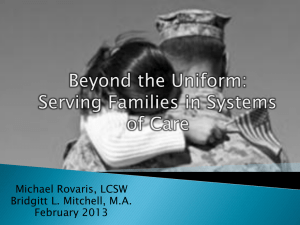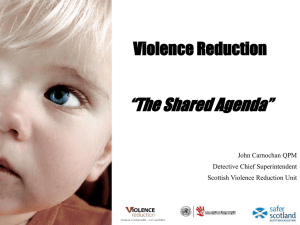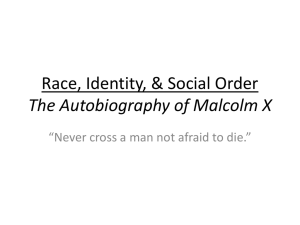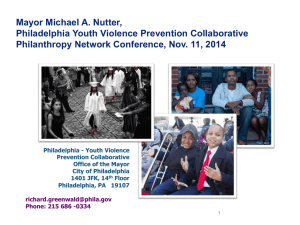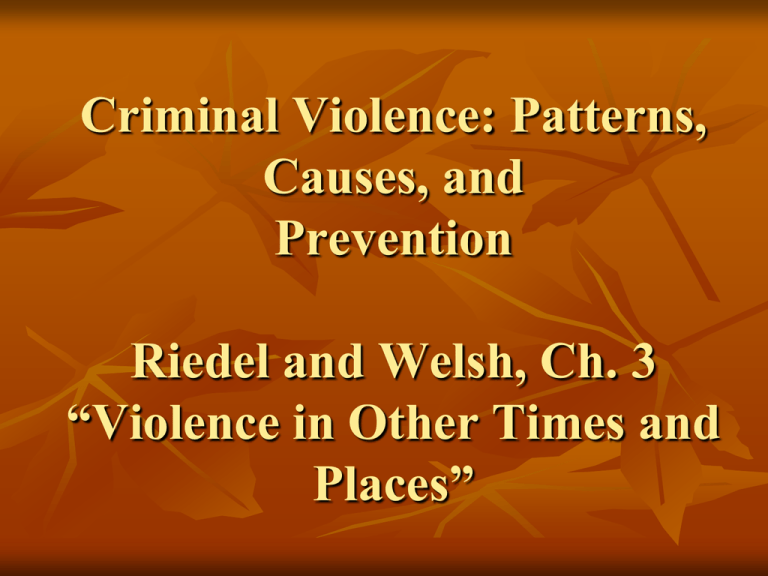
Criminal Violence: Patterns,
Causes, and
Prevention
Riedel and Welsh, Ch. 3
“Violence in Other Times and
Places”
OUTLINE
Difficulties in Studying Historical Violence
White-Native American Warfare
Slavery, African-Americans, and Violence
Social Banditry
Prohibition
Violence in Other Places
Difficulties in Studying Historical
Violence
Many myths and outright fabrications
Much information about violence in the U.S.
prior to the 20th century is fragmentary and
unreliable (e.g., poor records).
Violence has been the instrument not
merely of the criminal, but also of the
honorable (e.g., American Revolution;
dueling; feuding).
Q: Do the ends justify the means?
White-Native American Warfare
The “Trail of Tears”
1791 - Cherokees negotiated a peace treaty granting
land in parts of Georgia, Tennessee, and North
Carolina.
1819 - Gold deposits were discovered on tribal lands.
1828 - Georgia legislature outlawed the Cherokee
government and confiscated their land.
1830 - President Jackson used the Indian Removal Act of
1830 to forcibly remove the Cherokees from their land.
1832 - The U.S. Supreme Court ruled the Georgia
legislation was unconstitutional, but federal authorities
ignored the decision.
1835 - Federal troops forcibly evicted the Cherokees.
About 18-20,000 people were force-marched 800 miles to
“Indian Territory.” About 4,000 perished from hunger,
disease, and exposure.
Slavery, African-Americans, and Violence
Slavery was closely tied to the Southern economy,
particularly tobacco and cotton.
Initially, indentured servitude was used.
Over the years practice became custom, and custom
became law. In 1664, Maryland law stated all
“Negroes” were to be slaves for life and the children
of all female slaves were also to be slaves.
But: it was difficult to justify the obvious inequality
represented by slavery.
Only one revolt by slaves came to fruition, the Nat
Turner Rebellion (1831). Southern legislatures used
white fear generated by the revolt to impose even
greater restrictions on slaves.
Slavery, African-Americans, and Violence
(cont.)
Conflicts over slavery led to the U.S. Civil War.
Of the 2,500,000 who served in the Southern or
Northern armies, 620,000 men (1 in 4) died.
In spite of Lincoln’s Emancipation
Proclamation (1863) and victory of the North
(1865), discrimination remained due to legalized
segregation and discrimination (e.g.,
deprivation of voting rights).
More than 3,700 lynchings occurred between
1889 and 1930; over 80% occurred in the South.
Social Banditry (late 1800s)
After the Civil War:
There was enormous industrial growth in the
U.S.
But: few grew wealthy; many were left in
poverty.
Gangs organized for the purpose of robbery.
Many Americans saw outlaws as romantic figures,
heroes who “fight and die for the things that made
America great.”
Q: Was this violence for the sake of violence? Or
were they “rebels” against power and wealth?
Prohibition
The 18th Amendment to the Constitution
prohibited the sale, manufacture, distribution,
and importing of intoxicating liquors in the U.S.
Effective in 1920; repealed in 1933.
Prohibition produced a switch from lowpotency drinks (beer) to distilled spirits: easier
to transport, and less likely to spoil.
Consequences of Prohibition (?)
encouraged disrespect for the law
increased consumption of distilled spirits
increased the risk of consuming toxic substances
corrupted law enforcement
increased organized crime
Q: What lessons does history teach us about violence?
1. There have been occasions in history when many
people felt that the “ends justified the means.” (e.g.,
American Revolution, Civil War).
2. The least powerful have often been the targets of
violence (e.g., women, children, minorities).
3. Violence has frequently been used for economic gain
(e.g., slavery, prohibition-era gangsters, Trail of
Tears).
4. While we generally condemn violence against others,
violence is sometimes admired (e.g., outlaws of Wild
West, media coverage of gangsters).
5. Increased exposure to violence may have increased
our “desensitization” to violence over time.
Violence in Other Places
The International Police Organization
(INTERPOL) has collected and published crime
data from national police forces since 1950.
In 1974, the United Nations began surveys on
officially reported crimes, including homicides,
assaults, sex crimes, robberies, and kidnappings.
The best-known and most valid source of
information on international homicides is the
World Health Organization (WHO) of the United
Nations.
WHO has collected mortality statistics from national
health organizations since 1951.
Data are available for 40-55 nations each year.
http://www.who.int/violence_injury_prevention/violence/en/
Violence in Other Places (cont.)
Limitations of Cross-National Statistics:
1. Few variables; limited detail: (e.g., no data
on whether the homicide involved robbery,
domestic conflict, or weapons)
2. Variations in cultural and legal definitions
make it difficult to collect this kind of
cross-national data.
3. Available data are biased toward more
developed countries that have sufficient
resources and political stability to develop
adequate reporting systems.
Violence in Other Places (cont.)
Cross-national data on homicide are more
reliable than cross-national data on crimes such
as rape, robbery, and assault.
There is little doubt that the U.S. is more
violent than other developed democratic
countries in the latter 20th century (Fig. 3-1).
These countries were chosen for comparison
because they are economically and socially
developed democracies with well-developed
statistical reporting systems.
Figure 3-1
Homicide Rates in U.S., Finland, and United Kingdom
1980-2007*
12.0
Rate per 100,000
10.0
United States
Finland
United Kingdom
8.0
6.0
4.0
2.0
0.0
1980
1983
1986
1989
1992
1995
Ye ar
1998
2001
2004
2007


